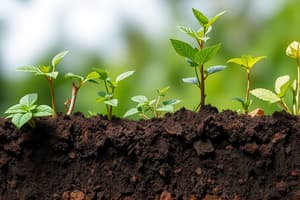Podcast
Questions and Answers
Which of the following best describes protozoa?
Which of the following best describes protozoa?
- Unicellular, eukaryotic, colourful, plant-like organisms
- Unicellular, eukaryotic, colourless, animal-like organisms (correct)
- Multicellular, prokaryotic, colourful, plant-like organisms
- Unicellular, prokaryotic, colourful, animal-like organisms
What is the characteristic feature of soil protozoa that enables them to withstand adverse soil conditions?
What is the characteristic feature of soil protozoa that enables them to withstand adverse soil conditions?
- Ability to photosynthesize
- Ability to form spores (correct)
- Presence of a rigid cell wall
- Ability to move quickly through the soil
How do most protozoa derive their nutrition in the soil?
How do most protozoa derive their nutrition in the soil?
- By absorbing nutrients from the soil directly
- By producing their own food through photosynthesis
- By feeding on soil fungi
- By ingesting soil bacteria (correct)
What is the function of some protozoa as biological control agents in agriculture?
What is the function of some protozoa as biological control agents in agriculture?
What is a potential risk associated with certain soil protozoa for human health?
What is a potential risk associated with certain soil protozoa for human health?
Which of the following is NOT a characteristic feature of soil protozoa?
Which of the following is NOT a characteristic feature of soil protozoa?
What is the primary locomotory organ for most soil protozoa?
What is the primary locomotory organ for most soil protozoa?
Which bacterial genera are commonly used as the food base for isolation and enumeration of soil protozoans?
Which bacterial genera are commonly used as the food base for isolation and enumeration of soil protozoans?
What is the size range of soil protozoa?
What is the size range of soil protozoa?
Why do soil protozoa play an important role in maintaining microbial/bacterial equilibrium in the soil?
Why do soil protozoa play an important role in maintaining microbial/bacterial equilibrium in the soil?
Protozoa are always microscopic in size.
Protozoa are always microscopic in size.
All soil protozoa are motile by flagella.
All soil protozoa are motile by flagella.
Soil protozoa play no role in maintaining microbial/bacterial equilibrium in the soil.
Soil protozoa play no role in maintaining microbial/bacterial equilibrium in the soil.
Some protozoa have been recently used as biological control agents against phytopathogens.
Some protozoa have been recently used as biological control agents against phytopathogens.
Several soil protozoa cause diseases in human beings which are carried through water and other vectors.
Several soil protozoa cause diseases in human beings which are carried through water and other vectors.
Flashcards are hidden until you start studying
Study Notes
Characteristics of Protozoa
- Protozoa are always microscopic in size.
- Not all soil protozoa are motile by flagella.
Soil Protozoa Features
- The characteristic feature of soil protozoa that enables them to withstand adverse soil conditions is not specified.
- Most soil protozoa are motile, but not necessarily by flagella.
Nutrition and Feeding
- Most protozoa derive their nutrition in the soil by consuming bacteria.
- Bacterial genera such as Pseudomonas and Bacillus are commonly used as the food base for isolation and enumeration of soil protozoans.
Biological Control Agents
- Some protozoa have been recently used as biological control agents against phytopathogens.
- They play a role in maintaining microbial/bacterial equilibrium in the soil.
Size and Importance
- Soil protozoa range in size from a few micrometers to several millimeters.
- Soil protozoa play an important role in maintaining microbial/bacterial equilibrium in the soil.
Human Health Risk
- Several soil protozoa can cause diseases in human beings, which are carried through water and other vectors.
Studying That Suits You
Use AI to generate personalized quizzes and flashcards to suit your learning preferences.




